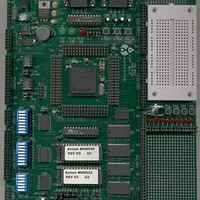MPC555CME Freescale Semiconductor, MPC555CME Datasheet - Page 193

MPC555CME
Manufacturer Part Number
MPC555CME
Description
KIT EVALUATION FOR MPC555
Manufacturer
Freescale Semiconductor
Type
Microcontrollerr
Datasheet
1.MPC555CME.pdf
(966 pages)
Specifications of MPC555CME
Contents
Module Board, Installation Guide, Power Supply, Cable, Software and more
Processor To Be Evaluated
MPC555
Data Bus Width
32 bit
Interface Type
RS-232
For Use With/related Products
MPC555
Lead Free Status / RoHS Status
Contains lead / RoHS non-compliant
- Current page: 193 of 966
- Download datasheet (13Mb)
4.5.1 Exception Table Relocation Operation
MPC555
USER’S MANUAL
When an exception is requested, the CPU initiates a fetch cycle that branches to the
exception routine associated with the exception that caused the fetch. The exception
addresses are fixed within the RCPU architecture and are 0x100 bytes apart from
each other, starting at address 0x0000_0100 or 0xFFF0_0100, depending on the val-
ue of the MSR[IP] bit.
If the relocation feature is disabled, the BBC transfers the exception fetch address to
the internal bus of the MPC555 / MPC556 with no interference.
In order to activate exception table relocation, the following steps are required:
If the relocation feature is enabled, the BBC translates the starting address of the ex-
ception routine into the address located at the lowest portion of the internal memory.
At that location, the user must insert a series (table) of consecutive branch instructions
that point to the appropriate exception routines.
Thus, the CPU branches twice to reach the appropriate exception routine.
1. Set the MSR[IP] bit. To set this bit out of reset, set the appropriate bit in the re-
2. Set the ETRE bit in BBCMCR register. See
3. Program absolute branch instructions at the locations indicated in
/
MPC556
set configuration word.
Register (BBCMCR)
pointing to the desired exception handler routines.
These branch instructions must utilize absolute addressing modes of
the RCPU (relative branches can not be used).
The eight Kbytes allocated for the exception table can be almost fully
utilized. This is possible if the MPC555 / MPC556’s address space is
not mapped to the exception address space — that is, if addresses
0xFFF0_0000 to 0xFFF0_1FFF are not part of the MPC555 /
MPC556 address space. In this case, these eight Kbytes can be fully
utilized by the compiler, except for the lower 64 words (256 bytes),
which are reserved for the exception pointers.
If the CPU issues any address that falls between two successive ex-
ception entries (e.g., 0xFFF0_0104), then an exception is generated
to the CPU if exception relocation is enabled. See
Configuration Register
for programming details.
Rev. 15 October 2000
BURST BUFFER
(BBCMCR).
NOTE 1
NOTE 2
NOTE
4.6.4 BBC Module Configuration
4.6.4 BBC Module
MOTOROLA
Table 4-1
4-17
Related parts for MPC555CME
Image
Part Number
Description
Manufacturer
Datasheet
Request
R

Part Number:
Description:
MPC555 Interrupts
Manufacturer:
Freescale Semiconductor / Motorola
Datasheet:
Part Number:
Description:
Manufacturer:
Freescale Semiconductor, Inc
Datasheet:
Part Number:
Description:
Manufacturer:
Freescale Semiconductor, Inc
Datasheet:
Part Number:
Description:
Manufacturer:
Freescale Semiconductor, Inc
Datasheet:
Part Number:
Description:
Manufacturer:
Freescale Semiconductor, Inc
Datasheet:
Part Number:
Description:
Manufacturer:
Freescale Semiconductor, Inc
Datasheet:
Part Number:
Description:
Manufacturer:
Freescale Semiconductor, Inc
Datasheet:
Part Number:
Description:
Manufacturer:
Freescale Semiconductor, Inc
Datasheet:
Part Number:
Description:
Manufacturer:
Freescale Semiconductor, Inc
Datasheet:
Part Number:
Description:
Manufacturer:
Freescale Semiconductor, Inc
Datasheet:
Part Number:
Description:
Manufacturer:
Freescale Semiconductor, Inc
Datasheet:
Part Number:
Description:
Manufacturer:
Freescale Semiconductor, Inc
Datasheet:
Part Number:
Description:
Manufacturer:
Freescale Semiconductor, Inc
Datasheet:
Part Number:
Description:
Manufacturer:
Freescale Semiconductor, Inc
Datasheet:
Part Number:
Description:
Manufacturer:
Freescale Semiconductor, Inc
Datasheet:










